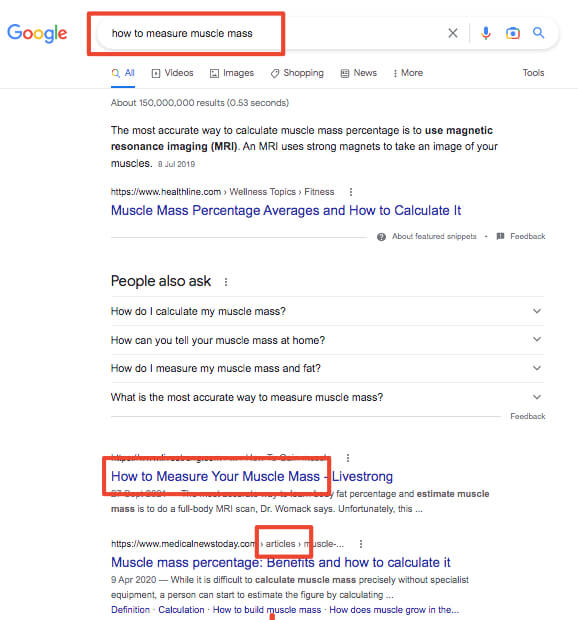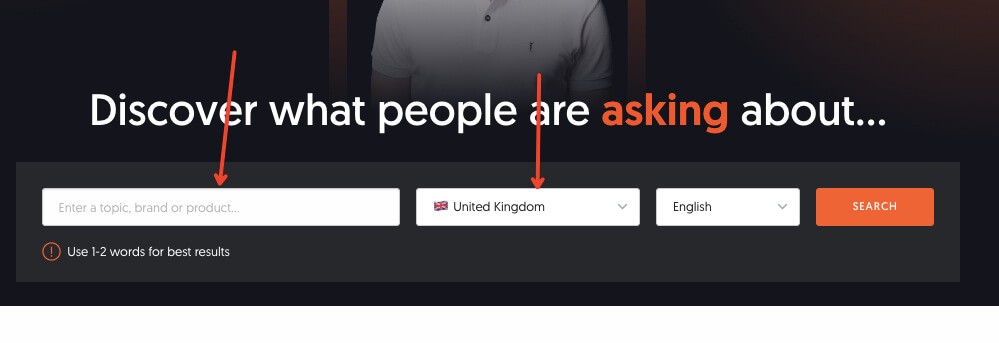Deciding to use keywords in your blogging strategy is a great step for your online business. Are you thinking about starting to optimise your blogs or creating new ones? Maybe you’re not sure of the benefits of SEO, or how keywords can help. We’ll explain how to use keywords in your blogging strategy.
What are keywords?
Keywords are terms that people enter into a search engine like Google, Bing or Yahoo. That means you can create content to target those keywords. You can then compete with other companies to rank for them in Google.
For example, when you enter the term ‘mens shoes for running’ into Google, Sports Direct, Pro Direct Sport, Sports Shoes and JD Sports are all competing. That means they’re in the top 4 organic listings. So people are more likely to click through to those companies.

Those are all category pages for ecommerce websites. Here is an example where blog articles are all ranking on page one of Google. This time the keyword is ‘how to build muscle mass’. The competitors are Healthline, Livestrong and Medical News Today.

But where do you start? How do you find the right keywords? How many people are searching for that keyword?
Fear not. Follow the instructions below. You will understand how to find the keywords. Then, think about which type of keyword you’ll want to target in your blog strategy. But we’ll get to that later.
Where can you find keywords?
There are a few ways you can find keywords. First, you need a keyword search tool. There are some free ones like Google Search Console. Go to ‘Performance’, then click ‘Queries’. Those keywords are giving you the impressions and clicks. See them? You can then optimise for those.
Alternatively, you can choose a keyword research tool that requires a monthly payment. There are plenty about. Check out Ahrefs or SEMRush to do your keyword research.
Next, find keywords by using the tool Answer The Public. Enter the search term you want to explore. Select the location you’re searching in. It will give you a list of the questions and search terms that relate to that topic. Use this for your content ideas. Check the search volume in your keyword tool.

Finally, another way to search keywords is to use a search forum like Quora or Reddit. You’ll need to create an account which is easy enough to do. Next, enter your topic in the search option. You’ll then be shown a list of the questions real people have asked on that forum.
Get a list of the questions. This might just be sub topics people are asking about. Then, find out the search volume and difficulty level in your keyword tool. Even if it’s low or has no search volume, we’d recommend creating an article targeting the question anyway. Why? Because you know people are looking for that data.
How to pick the right keywords: Getting search intent right
What’s the key to picking your keywords? Get your search intent right. It’s all well and good coming across hundreds of keywords or a list of keywords that have thousands of search volume. But you won’t get results if you choose the wrong type of keyword.
Your blog should educate your audience on how your product or service can solve their problem. So, firstly you need to make sure you have blogs that hit the pain points of those people and their problems. In other words, your first step is to make a list of those weak points.
For example, let’s say you sell low cost cleaning products and your primary audience is families and young mums. Your customer’s pain points are:
- Budget conscious
- Worried about the effect of germs in the house
- Don’t have time for hours of cleaning
That should fuel your content plans! Your content’s intent should be focused on highlighting:
- Affordability
- Statistics on the reduction/killing of germs
- How fast and easy your product kills the germs
In other words, don’t create articles that talk about premium end cleaning products. Avoid trying to encourage intense cleaning schedules. Don’t mention anything that might scare your audience or put any doubts in their mind about the effectiveness of your product.
Choose low-competition keywords
Consider targeting keywords that have lower competition because you’re much more likely to be able to rank for them. How can you check your SEO competition? Firstly, always make sure you use a keyword research tool because you need to be checking your online competitors.
What do we mean by online competitors? These are the companies and websites that appear in the Google SERPs for your keywords. You may have an idea of the offline companies. But those companies might be doing other forms of marketing and may not organically rank for the keywords you want to target.
So do a SERP check in your keyword tool to discover your online competitors. Then, you can ask yourself:
- What is their domain authority score like out of 100?
- How many backlinks do they have going to that page?
- What type and quality of backlinks do they have going to that page?
- How authoritative and valuable is that content?
- How well known is this brand?
The bottom line you need to decide is this. Can you compete with them realistically?
If yes, go for it!
If not, go back to the drawing board. Are there any similar search queries that have the same intent, but a slightly lower difficulty and competition level that you could still target? It’s a good idea to target long tail keywords here. We’ll get to that shortly.
How to use keywords in your blog
There are best practices when it comes to optimising your blog for your target keywords. Lots of SEO authorities will tell you the below. Follow these to rank for your term.
Include an exact match keyword in:
- URL slug eg www.yourwebsite.com/blog/this-is-your-target-keyword/
- H1
- Meta title
- Meta description
But don’t stop there! Look what the top 3 ranking competitors are doing, and ask yourself:
- How many times do they include their target keyword?
- Is it mentioned throughout the copy or just once near the start?
- How many Htags or Headings do they have?
- Have they included any images with an exact match keyword in the alt text and file name?
- Is their keyword in their URL?
Keyword mentions are one of the most important things to check for. Never assume you should throw in a few mentions and hope for the best. Manually count how many mentions your competitors include, and go for approximately the same amount.
Otherwise, you risk under-optimising or keyword stuffing. You want to avoid doing either of these as you won’t rank, and Google really doesn’t like a keyword stuffer. It sounds and reads spammy so it won’t be an easy read for your audience.
Target long tail keywords
Targeting long tail keywords can be a clever way of using keywords in your blogging strategy because you can have a better chance to rank for said term. Not always, but lots of the time, long tail keywords are less competitive.
What is a long tail keyword? A long tail keyword is a search phrase or query which contains at least three words, or more.
For example, let’s say your website sells washing machines. You’ve done the keyword research for terms and ‘sales’, ’prices’ and discounts, and there are thousands of searches made. It might be too competitive to try and rank for ‘washing machine sale’.
But there’s still hope, and an even better opportunity in fact! You could be far better off creating a blog article around the term ‘how much do washing machines cost 2023’. It might have less than 100 searches a month, or even less.
But you’ll have a far stronger chance of ranking if you create a helpful, optimised article, including:
- Table with some of your products and prices
- Average prices at other retailers
- Cost to run them at different times of the day
- Brief advice to keep costs low
- Question and Answers, eg:
- ‘How to pay for a washing machine’
- ‘Can I pay by credit card for a washing machine’
Make sure you’ve optimised for the basic aspects of SEO we mentioned earlier too, including your URL.
You should now feel more equipped to get started on your blogging strategy! Use these top tips on how to kickstart your brainstorming and create practical, optimised articles.
